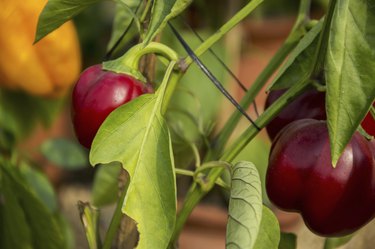
The best soil pH for peppers (Capsicum spp.) varies slightly depending on your soil. Soil pH near 6.0 is best in mineral soils, which have low levels of organic matter. In organic soils, pH near 5.6 is best. Typically grown as annuals in the United States, pepper varieties may be hardy from U.S. Department of Agriculture plant hardiness zone 9 through 12, according to Missouri Botanical Garden. Regardless of your pepper preferences, acidic soil helps them make the most of available nutrients.
Why pH Matters
Video of the Day
Without proper nutrition, peppers won't be table-worthy. Soil pH determines the availability of essential plant nutrients already in your soil and those you may add. Without pH in line, pepper nutrients stay out of reach. In high-pH soil, many micronutrients can't be absorbed by plants; nutrient deficiencies happen even though nutrients are plentiful.
Video of the Day
Soil pH also affects the way different elements interact. For example, potassium is most available in alkaline soil, but excess potassium limits the absorption of calcium that would otherwise be available. By getting soil pH near the optimal pepper levels, your peppers stay fueled with the nutrients they need most.
What Peppers Need
Peppers need all the nutrients other plants need, but they need them in different quantities. For example, too much nitrogen before peppers set their fruit leads to excess leaves and few peppers. Pepper plants also need specific nutrients to bear their best fruit.
Calcium is especially important to pepper development. Blossom end rot is caused by calcium deficiencies due to low calcium or improper soil pH. When heavy rainfall leaches alkaline-supporting nutrients from soil, calcium is among the first to go; low pH results. Knowing if deficiencies are due to pH or true shortages, determines what to do with your peppers and your pH.
How Soil Tests Help
Soil tests estimate the availability of nutrients based on current pH, soil type, organic matter and other components. Use a local or regional soil testing laboratory familiar with your area for recommendations on pH changes and missing nutrients. Let the lab know you're growing peppers; it can tailor your recommendations.
Always think in terms of pH ranges rather than absolutes. A soil pH of 7.0 is neutral. A lower pH indicates the soil is acidic, while a higher pH indicates the soil is alkaline. Peppers are not alkaline loving vegetables as the ideal ph level for bell peppers is between 6.0 and 6.5, advises Clemson Cooperative Extension
Even professional soil tests have an accuracy of plus or minus 0.5 pH unit. The time of year, the sample's salt and moisture content, and testing procedures all affect final results. If your target pH is 6.0, shoot for results between 5.5 and 6.5.
Best pH for Pepper Plants
Test your soil several months before planting peppers, so adjustments take hold before peppers hit the ground. Follow your test recommendations closely as amendments that work in one region may be ineffective elsewhere.
Incorporating organic matter and using organic mulches gradually lowers pH over time, making the soil more acidic. Elemental sulfur worked 6 inches deep into some soils at a rate of 1/2 pound per 100 square feet can lower pH by 1.0 unit.
Ground limestone makes the soil more alkaline and raises soil pH 1.0 unit in some soils when applied at a rate of 2.5 pounds per 100 square feet. Wear protective clothing, including gloves and safety goggles when working with soil amendments, and avoid contact with exposed skin.